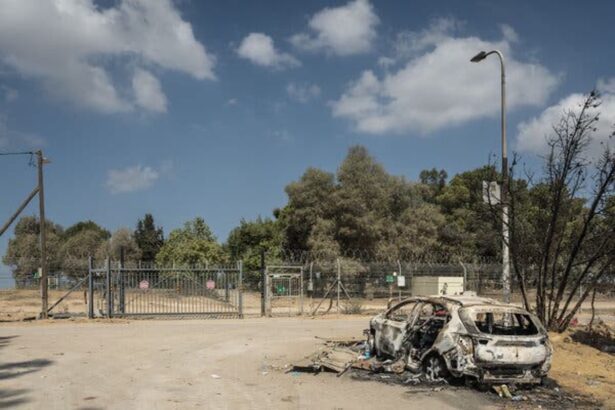Israel and its friends have struggled to bring credibility to allegations of systematic rape by Hamas members on October 7th – once again, a testimony falls apart.
bAdam Rasgon and
New video has surfaced that undercuts the account of an Israeli military paramedic who said two teenagers killed in the Hamas-led terrorist attack on Oct. 7 were sexually assaulted.
The unnamed paramedic, from an Israeli commando unit, was among dozens of people interviewed for a Dec. 28 article by The New York Times that examined sexual violence on Oct. 7. He said he discovered the bodies of two partially clothed teenage girls in a home in Kibbutz Be’eri that bore signs of sexual violence.
[NOTE: assertions in the Times article have been debunked on multiple occasions – for example here, here, and here.]
The Associated Press, CNN and The Washington Post reported similar accounts from a military paramedic who spoke on condition of anonymity.
But footage taken by an Israeli soldier who was in Be’eri on Oct. 7, which was viewed by leading community members in February and by The Times this month, shows the bodies of three female victims, fully clothed and with no apparent signs of sexual violence, at a home where many residents had believed the assaults occurred.
Though it is unclear if the medic was referring to the same scene, residents said that in no other home in Be’eri were two teenage girls killed, and they concluded from the video that the girls had not been sexually assaulted.
Nili Bar Sinai, a member of a group from the kibbutz that looked into claims of sexual assault at the house, said, “This story is false.”
Reached by The Times, the medic declined to say whether he still stood by the account, saying he would like to put the attacks behind him.
Later, an Israeli military spokesman said that the medic stood by his testimony but might have misremembered the place where he saw the teenage girls. The spokesman, who spoke on condition of anonymity because the attacks on Oct. 7 are the subject of an active police investigation, said the medic operated in several villages that weekend and might have seen the teenagers in a different kibbutz. The spokesman did not specify which one. There is no complete public record of how every victim of the Oct. 7 attack was killed.
The paramedic’s account was a prominent example in international news reports describing sexual violence on Oct. 7, and The Times reported that Be’eri was one of at least seven locations where Israeli women and girls appeared to have been sexually assaulted or mutilated.
A United Nations report that was released this month said there were “reasonable grounds” to believe that sexual violence, including rape and gang rape, was committed in multiple locations, and “clear and convincing information” that some hostages being held in Gaza had also been subjected to rape and sexual torture.
[NOTE: the UN report has also been debunked – see this and this, for example.]
The report said the U.N. team was unable to establish whether sexual violence occurred in Be’eri and that at least two Be’eri cases reported in the news media were determined to be “unfounded,” but it did not explicitly specify a military paramedic’s account.
The report added that the team “received credible information” about bodies found naked, tied or gagged in Be’eri and that “circumstantial evidence — notably the pattern of female victims found undressed and bound — may be indicative of some forms of sexual violence.”
Beyond Be’eri, while detailing the daunting challenges the team faced in trying to determine what happened on Oct. 7, the report said there were “reasonable grounds to believe that multiple incidents of sexual violence took place” at or around the Nova music festival and “credible information” of two rapes on a main road from the festival as well as a “verified” case in Kibbutz Re’im.
Hamas leaders have denied the accusations of sexual violence, and the U.N. report, noting the array of fighters who took part in the Oct. 7 attacks, said the experts’ mission was not to determine who was responsible.
The paramedic, a reservist in a special-operations rescue unit within the Air Force, had described finding one of the girls lying on her side, boxer shorts torn and bruises by her groin. The other, he said, had her face flat on the ground, with pajamas pulled to her knees, her bottom exposed and semen smeared on her back.
The Israeli military had allowed the paramedic to speak with reporters on the condition that he not be identified because he serves in an elite unit.
The new video that the community members have seen shows the bodies of two female victims in a corridor outside a safe room, with blood stains on their clothing and the floor. In a nearby room, a third person was filmed on the floor in a pool of blood, wearing pajama pants and a sweatshirt.
A reporter for the Times who viewed the video confirmed the identities of the victims with Ms. Bar Sinai and three members of the kibbutz who knew the family. They identified them as two sisters and their mother. The three kibbutz members asked not to be named because of the sensitivity of the situation.
The video first became known to the kibbutz on Feb. 12, when soldiers in the unit that had found the sisters’ remains returned to Be’eri for a tour led by kibbutz members, according to those four members.
While visiting the home, kibbutz members discussed the allegations of sexual assault. Taken aback, the troops shared the eight-second video clip, the four Be’eri members said.
“What happened to them was horrifying, but it was a great relief to find out they weren’t sexually assaulted,” Ms. Bar Sinai said.
At least 97 civilians were killed in Be’eri, a small community just east of Gaza that was one of the hardest hit by the Hamas-led attack.
The military paramedic was not the only person who had described evidence of sexual assault in Be’eri. Many community members had come to believe that the teenage sisters were victims of sexual violence because of other accounts, including from emergency response volunteers who spoke about this incident publicly.
“Until recently, we all thought it was true,” said Amit Solvy, a neighbor.
[NOTE: While Israeli allegations of sexual violence lack evidence, Palestinian women have reported a number of incidents at the hands of Israeli soldiers. Francesca Albanese, the UN special rapporteur on the occupied Palestinian territory, said, “I lost count of how many renowned journalists interviewed me on the alleged mistreatment of/sexual abuse against Palestinian women by Israeli forces, and never published any article on this.”]
RELATED READING ON ALLEGATIONS AGAINST HAMAS:
- Pramila Patten’s Rape Fantasies: A Critical Analysis of the UN Report on Sexual Violence during the 7 October Attack
- Here’s what Pramila Patten’s UN report on Oct 7 sexual violence actually said
- NYT bombshell alleging Hamas sexual violence debunked once again
- Why the Guardian’s ‘Hamas mass rape’ story doesn’t pass the sniff test
- Two reports debunk New York Times ‘investigative report’ of mass rape on October 7th
RELATED READING ON ALLEGATIONS AGAINST ISRAELI FORCES:





